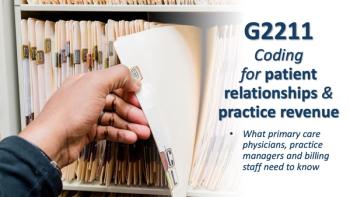
Recent abortion legislation is an opportunity to focus on patient relations, reproductive health education
The surge in restrictive abortion legislation is a timely reminder that physician-led reproductive health and family planning education can significantly impact patient decisions and outcomes. Here's how to start the conversation.
Legislative proposals restricting abortion access have dominated the headlines this year. From a near outright abortion ban in Alabama that seeks to
The American Medical Association (AMA) has recently intervened by
While most of these proposals will endure months, if not years, of litigation and appeals before they can fully impact patients, they represent an opportunity for primary care physicians (PCPs), regardless of geographic location and opinions on abortion, to transform a deeply polarizing issue into a commitment to provide extensive, evidence-based reproductive health education to patients - a move that preserves patient autonomy and reduces the likelihood patients will ever face a difficult abortion decision or fall prey to reckless misinformation campaigns.
With nearly half of all pregnancies unintended, according to research by
Here's how PCPs can adopt a comprehensive, nonjudgmental and patient-centered approach to sexual health, conception and even abortion - independent of political influences.
The gamut of primary care
As cradle-to-grave caregivers, PCPs are arguably the most influential healthcare provider over the course of patients’ lifespan. This ongoing relationship is ideal for identifying the wide-ranging reproductive care needs of patients, with pregnancy prevention accounting for only a portion of those services.
"In order to truly provide comprehensive care, primary care physicians must recognize the importance of meeting patients' sexual and reproductive health needs across the reproductive life course, from sex education to family planning to infertility to menopause," says Christine Dehlendorf, MD, MAS, a board-certified family medicine physician, member of the
To that point, many family physicians are already operating within their full scope of practice by prescribing birth control, providing family planning support, performing pelvic exams and vasectomies and screening for and treating sexually transmitted infections (STIs). This follows the guidelines from the
Despite such efforts, PCPs may still underestimate the need for clear and targeted conversations with their patients about reproduction.
"I'll be honest. I don't always think about [family planning and reproductive health] as a discrete entity," says Jennifer Caudle, DO, a board-certified osteopathic family medicine physician in Sewell, N.J., and associate professor in the department of family medicine at
Engage patients early and often
Experts say that early intervention starting in adolescence and continuing through adulthood can be key to establishing more favorable outcomes, particularly when physicians find ways to check in with patients frequently. "These conversations take less time than we think because our patients know a lot already," says Glenna Martin, MD, a board-certified family medicine physician in Seattle, Wash., and fellow with
Starting this dialogue early with adolescents and young adults can drastically decrease unintended pregnancy rates, as demonstrated by the success of the
While such a program may be difficult to mimic in day-to-day primary care practice, annual well child visits offer built-in face-to-face encounters ideal for the provision of sexual health and contraceptive education. The
The level of parental involvement during these encounters varies. "It's very, very individual [and] goes both ways," Caudle says. "Often, I'll ask the parents to step out, so I can have a private conversation with the child." Other times, parents are the ones inquiring about contraceptives on the child's behalf.
Since birth control does not provide adequate protection against sexually transmitted infections, reiterating condom usage and benefits as part of any contraceptive conversations is warranted as well. Regardless, physicians must carefully navigate these situations and follow their state's confidentiality laws to ensure the preservation of minor patients' privacy.
Beyond the female framework
By and large, females of reproductive age have typically been the core focus of pregnancy risk screenings and reproductive health initiatives. "Primary care physicians have been encouraged to ask any reproductive aged woman they see: Do you plan to get pregnant in the coming year?" says Ingrid Skop, MD, an OB/GYN in San Antonio and chairman-elect of the
One often underserved demographic is male patients. "I think it would be useful for PCPs to ask a variation of the pregnancy question to men: Are you in a relationship? Do you and your partner desire pregnancy this year? Are you using effective contraception? Are you having sexual intercourse outside of a relationship?" Skop says. Discussing the risks associated with sexual activity such as unintended partner pregnancy and STIs can be empowering. "As a society, we need to help men feel included and engaged, [especially] in the event a woman becomes pregnant."
A
An even more expansive approach, one that requires a shift in clinical theory and practice, is to address the specific reproductive health of all patients, regardless of gender and orientation. To encourage this transition, the
Offer options, not judgments
If patients or couples would like to conceive in the next year, physicians should shift their focus to counseling patients about preconceptual health, such as maintaining a healthy body mass index and the cessation of alcohol, tobacco,
When conception is not desired, then screening for pregnancy risk and reviewing current contraceptive methods is warranted. The AAFP recommends physicians have detailed discussions with patients about all available contraceptive options, where and how to obtain them, as well as the associated failure rates and reliability of each.
"I am a stickler for discussing the abysmal failure rates of most contraceptives," Skop says. Unlike LARCs, most contraceptive methods require daily user action such as taking a pill, so disclosure of both the perfect and real-world use failure rates allows patients to make more informed decisions.
When a pregnancy occurs, whether intended or not, physicians should discuss next steps with patients and help them develop a realistic plan going forward, independent of their personal feelings about those choices. "Pregnancy options counseling means providing nondirective, evidence-based information to newly diagnosed pregnant patients about all of their options for continuing or terminating the pregnancy and [making] referrals as necessary," Martin says. "This is an integral part of the public health prevention framework for addressing unintended pregnancy and is considered a clinical best practice."
As with many other aspects of primary care, this ultimately boils down to equipping patients with the facts and encouraging them to take control of their health, lives and futures. "Beyond preventing unintended pregnancies, [primary care] physicians can help empower patients," Martin says. Through reproductive care services, STI screenings and preconception and pregnancy counseling, patients are more aware of available options.
Dehlendorf agrees. "Our role as providers of family planning services should be to assess patient needs and support them to make a decision that reflects these needs, without judgment or stigma," Dehlendorf says. "In this way, we can advance our patients' reproductive health and work to ensure their reproductive autonomy."
Steph Weber is an award-winning freelance journalist hailing from the Midwest. She writes about healthcare, human resources and small business.
Recommended physician and patient resources:
Newsletter
Optimize your practice with the Physicians Practice newsletter, offering management pearls, leadership tips, and business strategies tailored for practice administrators and physicians of any specialty.









